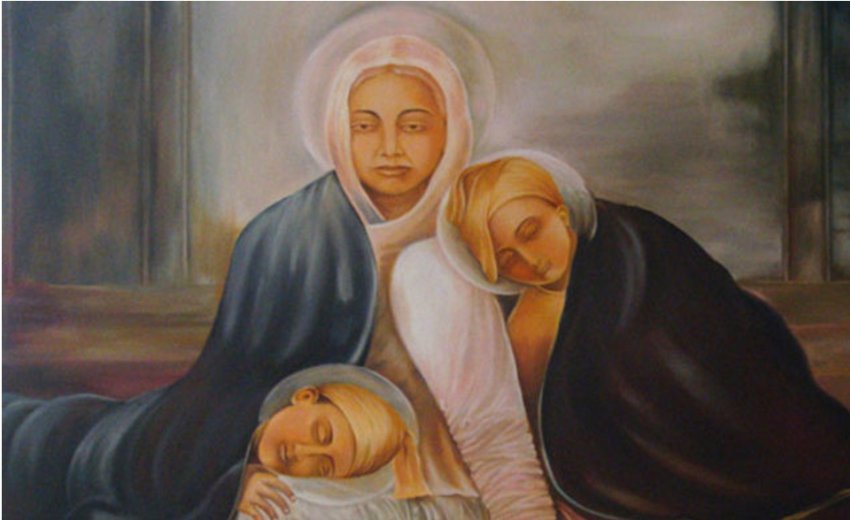Who is not familiar with the traditional story of Mata Gujri and Chotte Sahibzade held captive by the Mughals, their tower imprisonment, and being bricked to death for the refusal to accept Islam as their religion? However, this is the sanitized and whitewashed version of their story. There is much more to it. Here we share with you the untold history of the Chotte Sahibzade and Mata Gujri Ji based on research by Dr. Mohan Singh Dhariwal.
The Anandpur Sahib was under siege by the Hindu Hill Chiefs and Mughal troops who were hostile toward Sikhs, in1705. Several battles were fought during that time. A peace treaty was offered by the Mughals and the Hindu Chiefs to the Sikhs. In this treaty, they swore on their individual Gods and promised that if Guru Sahib accompanied by his army would leave the fort of Anandpur they would not attack him and his people. Guru Gobind Singh was aware of the fake promises made by the Mughals and the Hill Chiefs, yet on the insistence of his army decide to leave the fort. During the winter of 1705, the Sikhs evacuated Anandpur Sahib as ordered in the treaty (6-7 Poh, Sambat, 1762). However soon thereafter, Aurangzeb’s generals along with the Hindu Hill Chiefs broke the treaty and attacked the Sikhs near present-day Majri, Punjab. During this battle, Mata Gujri Ji along with Guru Sahib’s younger sons Baba Zorawar Singh Ji and Baba Fateh Singh Ji were separated from the caravan of Guru Ji at the edge of the River Sarsa. A Gurudwara Sahib is also built up there in their honor “Gurudwara Pariwar Vichhora Sahib”.
Mata Gujri and the Chhote Sahibzadeh went on foot to the town of Chak Dhera. They spent the night there at Kumma Mashki's hut and ate their last meal offered by Brahmani Lakshmi. Kumma Mashki, a ferry operator and water carrier, was a Muslim by birth, but he supported and allied with the Sikhs.
As per history, it is quite unclear how Mata Ji and Sahbzade met Gangu. A former servant, Gangu, a Kashmiri pandit, saw them and suggested that they come with him to his village. They were grateful for his help and went with him. However, the servant breached their trust and in greed for money, then turned her and the Sahibzadeh over to Jani Khan and Mani Khan, local Mughal authorities in the town of Morinda. They were housed here in kotwali (jail). The Sahibzadeh were subjected to torture while in Mughal custody to persuade them to convert to Islam. When they refused to accept Islam, they were transferred to Sirhind, where the local Mughal emperor Nawab Wazir Khan received them.
As per Bhai Duna Singh Hindoria (Guru Gobind Singh Ji's contemporary and documentarian), to transport the Sahibzadeh, 35 km from Morinda to Sirhind, the Mughals tied the Sahibzadeh's hands and feet, stuffed them in sacks, and tied them to the sides of a horse. The hands and feet of Mata Gujri were also tied, and a large, inverted pot containing hot chili peppers was placed over her head and face. All this was done to torture them and convince them to convert their religion to Islam.
In Sirhind, Mata Gujri and the Sahibzadeh were locked in a Thanda Burj (cold tower) designed for the nawab's (regional ruler's) summer. In the winter, the North winds blowing down from the Himalayan mountains would have made it very cold for Mata Gujri and the Sahibzadeh because they were imprisoned, perhaps without any winter clothing.
The next morning, the Sahibzadeh were presented to Nawab Wazir Khan for the first time. In the courtroom, when they arrived, they were instructed to enter through a small door. One of the guards bowed his head as he entered the door. Instead of lowering their heads to enter, which would have signaled submission, the Sahibzadeh walked in feet-first and greeted Wazir Khan with "Waheguru Ji Ka Khalsa, Waheguru Ji Ki Fateh." To gain favor with Emperor Aurangzeb, Wazir Khan tried to convert the Sahibzadeh to Islam by promising massive rewards and riches. The authorities tortured the Sahibzadeh for two days as the Sahibzadehs repeatedly refused to accept Islam as their religion. As a punishment, the Sahibzadeh were whipped with thin mulberry branches. Their hands were doused with kerosene and lit on fire as they were not accepting Islam. There was a night when they were tied to a tree and stoned with slingshots, during which Zorawar Singh lost an eye. Despite all, the Sahibzadeh remained resolute in their Sikhi and the teachings of the Guru.
A devotee of Guru Gobind Singh Ji, Moti Ram Mehra, decided that he would risk his life but would provide milk to the Chhote Sahibzadeh and Mata Ji. On one of the nights, he climbed a tree adjacent to the Thanda Burj, lowered himself into the tower, and provided them with warm milk. Sadly, he was caught by the Mughals, who put him, his wife, his children, and his mother to death by pressing them through a Kohlu (stone grinder).
The court disagreed on the morality of the execution while Mata Gujri and the Chhote Sahibzadeh were in Mughal custody. Among these Sucha Nand, supported their execution, while the Nawab of Malerkotla, Sher Mohammad Khan, argued against their execution and wrote to Aurangzeb citing that Sharia (Islamic Law) opposed taking the lives of children. The court dismissed his argument.
The Sahibzadeh were bricked alive in the final effort to convert them to Islam. But despite numerous attempts, the wall kept collapsing. After that, the Mughal executioners Shashan and Bashan Baeg threw the Sahibzadeh on the floor, knelt on the Sahibzadeh's chests, and slit their throats in a manner similar to the Zabiha or Dhabihah (the ritual of slaughter in Islam). The death of Zorawar Singh was quick, but the death of Fateh Singh took Adhee Ghari (about 13 minutes), as his feet quivered during that time.
Following this, the Mughals most likely tossed Mata Gujri, who was 81 years old, off the tower to her death. Given her fervent devotion to the Sikh cause and her steadfast faith, it is impossible to accept that Mata Ji committed suicide, as some writers have suggested. This place where this heinous and cold-blooded crime was committed is known as “Jyoti Swaroop Gurudwara Sahib” at Fatehgarh Sahib, Punjab, India.
Todar Mal a wealthy jeweler and an ardent follower of Guru Gobind Singh Ji sought to claim the Sahibzadeh and Mata Gujri's bodies for cremation. The authorities would only permit him to do so if he had the money to pay for the land required for the cremation. The price was the amount of vertically stacked gold coins needed to cover the necessary area.
Todar Mal was nevertheless able to carry out Mata Gujri and the Sahibzadeh's final Sikh rites, even though it left his family Penniless.
The entire narrative is gripping and compelling.
The Sahibzadeh's bravery and commitment are all the more remarkable considering that they not only refused to convert to Islam also underwent such horrifying torture. This untold version makes us feel more connected to our history and more empathetic to Mata Gujri and the Sahibzadeh’s plight.
The Sikhs cheerfully sing, “To martyrdom, we are wedded. We turn not our backs upon it.”
To sacrifice one’s life to uphold dharma has been an integral part of the Sikh faith. “Sikhi Sidak Na Jave” is a strong message that we should all learn from their sacrifice.
The martyrdom of the Sahibzades is honored every day during Ardas, and the Sikhs observe "Shahidi-hafta" (martyrdom week) from December 21 to 26. The Sikhs go to Fatehgarh Sahib to honor the martyrs and to ask God to instill the spirit of sacrifice in their lives.

